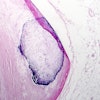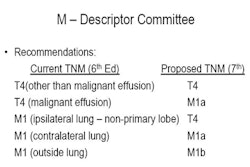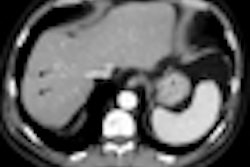The presence of extracolonic findings at virtual colonoscopy (also known as CT colonography or CTC) is a double-edged sword for practitioners, but constitutes a net positive benefit for patients, according to a presentation at the recent International Symposium on Multidetector-Row CT in San Francisco.
Presenting statistics on extracolonic findings from his own facility, Dr. Perry Pickhardt, associate professor of radiology at the University of Wisconsin in Madison, said the search for extracolonic findings is as unavoidable as it is limited.
"Radiologists are responsible for everything on the image, so we consider it unethical to simply ignore any area that's imaged," he said.
At the same time, it's important to remember that many abnormalities will be missed, even when they're within the field-of-view.
For that reason, CTC reports from University of Wisconsin health clinics always contain a disclaimer, stating that "extracolonic evaluation is limited by the lack of IV contrast and low-dose CT technique," Pickhardt said.
Extracolonic findings are really a double-edged sword, he said. On the plus side, the great majority of patients are happy to hear some reassurance of good health, and a minority benefit from early detection of unsuspected disease.
On the other hand, there are patients who must endure "undue anxiety, hassle, and costs stemming from additional workup for findings that ultimately prove to be of no consequence," he said.
The goal of extracolonic evaluation is to identify unsuspected yet important pathologies, while limiting the frequency of further workup as much as possible.
The issue of extracolonic findings has become central to the whole CTC debate. Referring physicians are often fearful of unleashing a workup cascade that can be as expensive as it is risky to the patient. But gauging the importance of imaging findings is certainly nothing new for radiologists, Pickhardt said.
"CT always evaluates more than the indicated area, and it's the radiologist's job to examine the entire imaged region and use careful judgment in determining which findings require further consideration," he said.
A reasonable approach for radiologists is to neither "advertise nor overemphasize" their ability to detect potentially serious abnormalities, he said. Although CTC is indicated for detecting colorectal cancer, the overall benefit related to CT screening of extracolonic structures remains unproven from a scientific standpoint. Pickhardt believes that this situation will soon change as more data are collected.
"And contrary to what some have suggested, overcalling findings is not the way to keep [gastrointestinal] docs from performing CTC," he said. Remember that nearly everyone has a finding of some kind or other, and "if you're the nervous, defensive-minded type with a tendency to overcall, maybe reading CTC studies is not something you should get involved with."
In a recent University of Wisconsin study that evaluated 2,195 consecutive asymptomatic adults with virtual colonoscopy, new findings of potential significance were found in 8.6% of patients, he said, well within the expected range of 7.4% to 11.4% seen in four prior studies.
Further diagnostic workup was recommended or suggested in 7.2% of patients, and actual diagnostic workup, "mostly additional imaging tests," Pickhardt said, including CT, ultrasound, or MR, was performed in 6.1% of screening subjects. There were no complications from additional workup in any patients, Pickhardt said.
Relevant new diagnoses were found in 2.6% of patients, and the cost of the additional imaging workup was calculated at $31.02 per case when divided among all VC studies performed. Cost estimates in prior studies have ranged from $24 to $34 studies.
For distinguishing important or potentially important findings from unimportant ones, extracolonic findings are categorized according to C-RADS, a system for CTC that is analogous to the BI-RADS system for mammography. C-RADS categories for extracolonic findings include:
- E0 - "limited" (not used in practice)
- E1 - normal
- E2 - unimportant finding
- E3 - likely unimportant, incompletely characterized
- E4 - potentially important
CTC screening does result in the detection of unsuspected cancers, Pickhardt said. To date, his facility and the National Naval Medical Center in Bethesda, MD, have found 36 cases among 10,286 adults screened with CTC -- about 0.35% or one out of every 286 CTC screenings. Findings included:
- 11 renal cell carcinomas
- 8 lung cancers
- 6 non-Hodgkin's lymphomas
"The stages are lower and survival higher compared to the [Surveillance, Epidemiology, and End Results (SEER)] database, so it does appear we are finding these cancers at an earlier stage than they would be detected without screening," Pickhardt said.
CTC screening also presents opportunities for combined screening studies as part of the routine scan -- for example, aneurysm screening, undisclosed genetic conditions, osteoporosis, hepatic steatosis, nephrolithiais, and abdominal aortic calcium scoring, he said.
"There are opportunities for early disease detection as well as pitfalls in the search for extracolonic abnormalities at CTC," Pickhardt said. "But we believe that when carefully and responsibly performed, the search for extracolonic abnormalities can produce a net positive effect on the health of the patient."
By Eric Barnes
AuntMinnie.com staff writer
June 1, 2009
Related Reading
VC finds serious extracolonic lesions in older patients, April 22, 2009
Adding CAD to virtual colonoscopy saves lives and money, February 24, 2009
VC's extracolonic findings lend an edge in cost-effectiveness, April 15, 2008
VC in elderly patients yields extracolonic advantage, November 7, 2007
Extracolonic findings double VC costs, but might be worth paying, July 20, 2006
Copyright © 2009 AuntMinnie.com




















